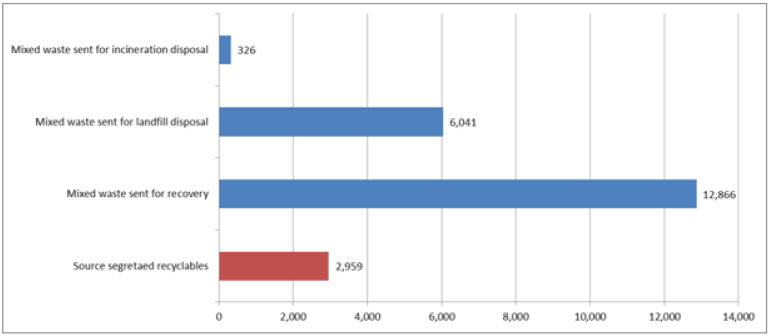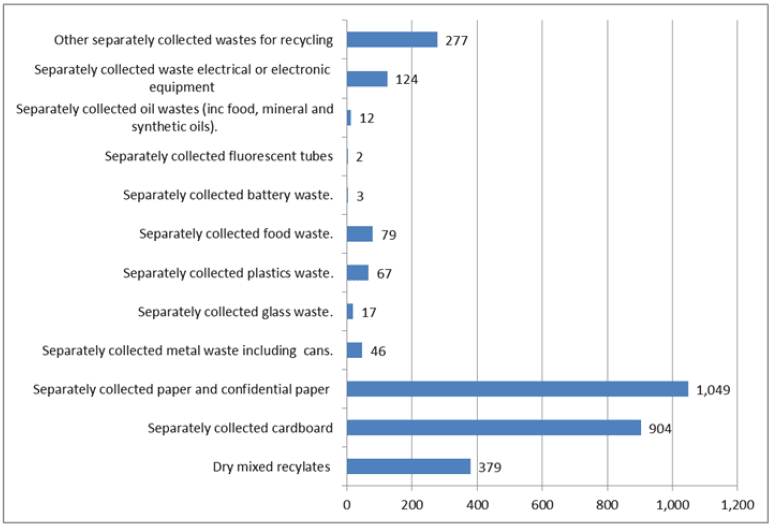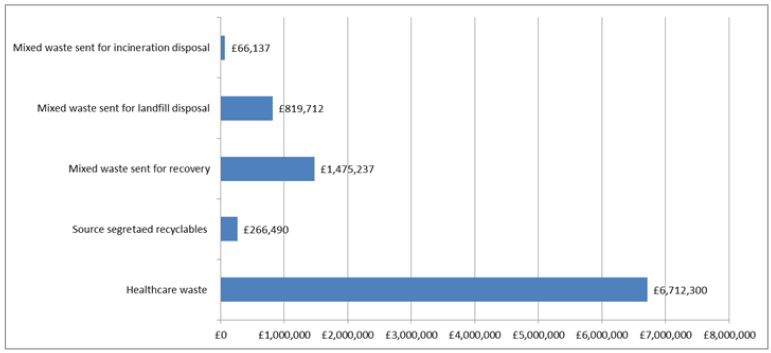Annual State of NHSScotland Assets and Facilities Report for 2013
A review of asset and facilities management performance in NHSScotland, identifying the current state of the estate and facilities management, highlighting areas of best practice and areas for improvement.
Annex D: Review of Waste Services
Waste data are reported on a Board-wide basis as this was identified and approved as the most appropriate way to collate and report waste performance. Given the challenges that NHSScotland faces with respect to waste management, it is key that data are obtained in the most accurate and consistent way by all Boards.
The 2011-12 data show that there are consistent practices in place for the management of healthcare waste and that Boards are, in general, using the national colour coding as described in NHSScotland SHTN3 Waste Guidance5. The only exceptions to this are the National Waiting Times Centre and NHS Borders. NHS Borders uses yellow bags to reflect the management of waste in its in-house waste incinerator and the National Waiting Times Centre is yet to transfer to the national colour coding system.
In 2011-12, 17,151 tonnes of solid healthcare waste were produced: only 856 tonnes (approximately 5%) of this were classified in the 'yellow stream' and required disposal using specialist incineration. The majority of healthcare waste was placed in the 'orange stream' and was treated to render it safe.
In addition to solid healthcare waste, NHS Boards produced 10,216 litres of red stream healthcare waste requiring other specialist treatment, for example chemical waste management and amalgam disposal.
The yellow, orange and red healthcare streams are all classified as hazardous waste and require consignment notes (regulatory forms to be completed) prior to removal of the waste from a site. In 2011-12, it is estimated that NHS Boards spent over £427,000 on consignment notes (this is paid to the Scottish Environment Protection Agency).
Figure 1 below shows tonnes of domestic waste reported by management route in 2011-12 from all Boards.
Figure 1: Domestic Waste Tonnages (all Boards)

A total of 22,191 tonnes of domestic waste was reported for 2011-12. Only 13% of this was sent for recycling or material recovery from material source segregation (see data shown in red on chart). There was a reliance on mixed waste recovery, with nearly 60% of all domestic waste being treated this way. Mixed waste recovery involves no sorting at source: filled bags of mixed domestic waste (usually black bags, but sometimes clear) are transported off site and opened at a material reclamation facility (MRF) where recyclable material is removed and the residue is disposed of in landfill. Information provided by NHS Boards suggests that 80% of all mixed waste sent for material recovery at MRFs is recycled, with only 20% being disposed of in landfill.
Scotland's Zero Waste Plan published by the Scottish Government in 20106 introduced a long term target of 70% recycling for all waste arising in Scotland by 2025. The domestic waste data for 2011-12 show that with respect to that target, NHS Boards' current practices are moving towards meeting the target, with an estimated combined material recovery rate from source segregation and MRF sorted materials of 61%.
However, current practices will not comply with the requirements of the Waste (Scotland) Regulations 2012 which require material separation at source. Contracts which permit mixed domestic waste being sent to MRFs for separation of recyclable materials and disposal of the residual waste will not be compliant.
A number of NHS Boards already source segregate recyclable materials, either as single material types or as mixed dry recyclates. Figure 2 shows material type and tonnage presently recycled across all NHS Boards.
Figure 2: Recyclate Materials Annual Tonnage

The data demonstrate that a large number of material types are currently segregated on NHSScotland premises and sent for recycling. In order to meet the requirements of the Waste (Scotland) Regulations 2012, NHS Boards need to build on current practice in a consistent way, ensuring all NHS Boards meet the requirements.
The 2011-12 data (Figure 3) show that a total of £9,339,877 was spent by NHS Boards; over 70% of this was spent on the management of healthcare waste.
Figure 3: Waste Management Expenditure (All NHS Boards)

Future Plans
The focus for 2012-13 is for Boards to improve domestic waste management and meet the requirements of the Waste (Scotland) Regulations 2012. The Regulations require the source segregation and separate collection of dry recyclables (paper, cans, card, plastics and glass) by 1st January 2014. They also put in place a total ban on the disposal of food waste to the public sewer (to come into force on 1st January 2016).
Through improved waste management, NHSScotland has the opportunity to make financial savings. The biggest impact will come from a reduction in the amount of healthcare waste through improved segregation. However, improved domestic waste segregation may also result in savings as revenue can often be gained from the sale of recyclates.
Contact
Email: Gillian McCallum
There is a problem
Thanks for your feedback